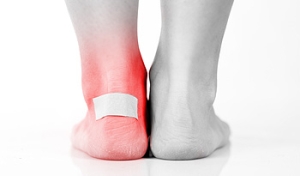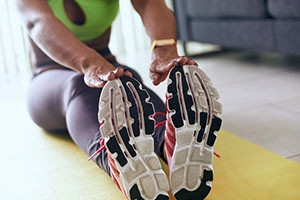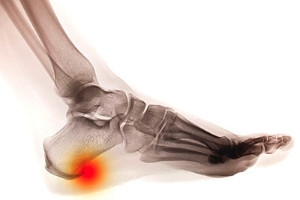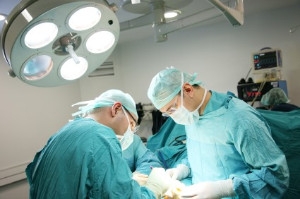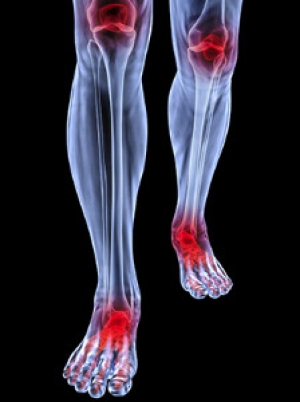
Wound Care
Diabetics must be wary of all wounds, regardless of depth or size. Diabetes, a chronic disease in which the body cannot properly use glucose the way it normally would, causes various complications that make wounds difficult to heal. Nerve damage or neuropathy will cause diabetics to have trouble feeling the pain of a blister or cut until the condition has significantly worsened or become infected. A diabetic’s weakened immune system can make even the most minor of wounds easily susceptible to infection. Diabetics are also more prone to developing narrow, clogged arteries, and are therefore more likely to develop wounds.
Wounds should be taken care of immediately after discovery, as even the smallest of wounds can become infected if enough bacteria build up within the wound. To remove dirt, wounds should be first rinsed under running water only. Soap, hydrogen peroxide, or iodine can irritate the injury and should be avoided. To prevent infection, apply antibiotic ointment to the wound and cover it with a bandage. The bandage should be changed daily. The skin around the wound may be cleaned with soap.
To prevent further exacerbation, see a doctor—especially if you have diabetes. Minor skin conditions can become larger problems if not properly inspected. As the wound heals, make sure to avoid applying pressure to the affected area.
Understanding Blisters
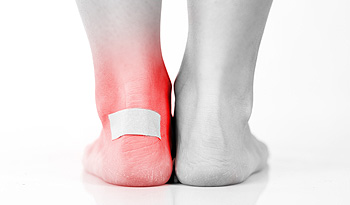 Blisters are a common annoyance caused by friction. They usually appear on the back of the ankle and are visible bubbles filled with fluid. The fluid inside of a blister varies. A blister can be filled with pus, blood, or serum. This condition causes itching, pain, or discomfort. Discomfort is usually unavoidable when the blister is located on the back of the ankle, because it will rub against any footwear. Blisters shouldn’t be popped because exposing the skin underneath could easily lead to an infection. If a blister does pop, then stay away from alcohol, hydrogen peroxide, and iodine. It is best to clean the skin with warm water and a gentle soap. After washing the area, apply antibiotic ointment and cover loosely with a clean bandage. There are situations when blisters should be drained, but it is best to let a professional drain the bubble. If you have an uncomfortable blister and would like to learn more about how to properly treat it, then it is suggested you consult with a podiatrist.
Blisters are a common annoyance caused by friction. They usually appear on the back of the ankle and are visible bubbles filled with fluid. The fluid inside of a blister varies. A blister can be filled with pus, blood, or serum. This condition causes itching, pain, or discomfort. Discomfort is usually unavoidable when the blister is located on the back of the ankle, because it will rub against any footwear. Blisters shouldn’t be popped because exposing the skin underneath could easily lead to an infection. If a blister does pop, then stay away from alcohol, hydrogen peroxide, and iodine. It is best to clean the skin with warm water and a gentle soap. After washing the area, apply antibiotic ointment and cover loosely with a clean bandage. There are situations when blisters should be drained, but it is best to let a professional drain the bubble. If you have an uncomfortable blister and would like to learn more about how to properly treat it, then it is suggested you consult with a podiatrist.
Blisters may appear as a single bubble or in a cluster. They can cause a lot of pain and may be filled with pus, blood, or watery serum. If your feet are hurting, contact one of our podiatrists of PA Foot & Ankle Associates. Our doctors can provide the care you need to keep you pain-free and on your feet.
Foot Blisters
Foot blisters are often the result of friction. This happens due to the constant rubbing from shoes, which can lead to pain.
What Are Foot Blisters?
A foot blister is a small fluid-filled pocket that forms on the upper-most layer of the skin. Blisters are filled with clear fluid and can lead to blood drainage or pus if the area becomes infected.
Symptoms
(Blister symptoms may vary depending on what is causing them)
- Bubble of skin filled with fluid
- Redness
- Moderate to severe pain
- Itching
Prevention & Treatment
In order to prevent blisters, you should be sure to wear comfortable shoes with socks that cushion your feet and absorb sweat. Breaking a blister open may increase your chances of developing an infection. However, if your blister breaks, you should wash the area with soap and water immediately and then apply a bandage to the affected area. If your blisters cause severe pain it is important that you call your podiatrist right away.
If you have any questions, please feel free to contact one of our offices located in Allentown, Easton, Northampton, and Chew Street in Allentown, PA . We offer the newest diagnostic and treatment technologies for all your foot care needs.
Blisters
Blisters are small pockets of fluid that occur on the top layers of the skin for several reasons. Friction, burns, and diseases are all known causes of blisters. Smaller blisters are known as vesicles, while larger blisters are referred to as bulla. The fluid inside the bubble can be blood, pus, or serum; which is a clear liquid that protects the skin. In most cases, blisters are not a major health issue, but they can be an indicator of a more serious condition.
Causes of blisters vary. Blisters are commonly caused by wearing poorly fitted shoes that rub against the foot. However, there are many other causes besides from friction; including burns, sunburn, insect bites, frostbite, poison ivy/oak, chemical exposure, impetigo, eczema, viral infections, and more.
Most blisters heal by themselves and do not require immediate medical care. If you have a blister, do not pop it since this may cause infection; it is advised to put a bandage over the blister to protect it. If the blister is large, causes pain, or if you have a fever, it is recommended that you see a doctor who can provide proper care. Blisters are easy to diagnose, and if considered prudent by the doctor, can easily be drained of fluid with a sterile needle as well.
To prevent blisters on the feet, wear shoes that fit properly and don’t cause rubbing. Socks can help prevent friction and it is recommended that you wear them if you are wearing shoes. Hand blisters can be avoided by wearing gloves during activities that cause friction against the hand. If you have a blister that pops, do not remove the dead skin, wash the area, apply antibiotic ointment, and cover with a bandage. It is okay in most cases to not seek immediate medical care for a blister if it was just caused by friction. However, if the blister causes pain or does not go away, it is suggested that you see a doctor for a diagnosis.
Having a Strong Body May Help to Prevent Running Injuries
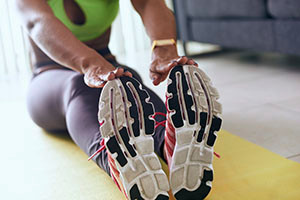 People who enjoy the sport of running or jogging may be familiar with uncomfortable running injuries. The runner may be temporarily forced to cease running as a result of these injuries. Research has shown there are methods that can be implemented, which may prevent running injuries. These may include gradually increasing the miles and intensity, which may be accomplished with a training schedule. Additionally, wearing running shoes that fit correctly may help painful injuries from occurring, and performing frequent stretches may help the feet to remain limber and flexible. Many runners find it beneficial to maintain proper form and posture while running and practicing core exercises may help to strengthen the overall body. If you would like to learn about how to prevent running injuries, it is suggested that you speak to a podiatrist who can provide you with additional information.
People who enjoy the sport of running or jogging may be familiar with uncomfortable running injuries. The runner may be temporarily forced to cease running as a result of these injuries. Research has shown there are methods that can be implemented, which may prevent running injuries. These may include gradually increasing the miles and intensity, which may be accomplished with a training schedule. Additionally, wearing running shoes that fit correctly may help painful injuries from occurring, and performing frequent stretches may help the feet to remain limber and flexible. Many runners find it beneficial to maintain proper form and posture while running and practicing core exercises may help to strengthen the overall body. If you would like to learn about how to prevent running injuries, it is suggested that you speak to a podiatrist who can provide you with additional information.
Exercising your feet regularly with the proper foot wear is a great way to prevent injuries. If you have any concerns about your feet, contact one of our podiatrists of PA Foot & Ankle Associates. Our doctors will treat your foot and ankle needs.
How to Prevent Running Injuries
Many common running injuries are caused by overuse and overtraining. When the back of the kneecap starts wearing out and starts causing pain in your knee, this is commonly referred to as runner’s knee. Runner’s knee is a decrease in strength in your quadriceps and can occur if you’re not wearing properly fitted or supporting shoes. To prevent runner’s knee, focusing on hip strengthening is a good idea, as well as strengthening your quads to keep the kneecaps aligned.
What Are Some Causes of Running Injuries?
- One cause of a common running injury is called iliotibial band syndrome.
- Plantar fasciitis is also another common injury.
- Stress fractures can occur from overtraining, lack of calcium, or even your running style.
Best Ways to Prevent Running Injuries
- Wear footwear that fits properly and suits your running needs.
- Running shoes are the only protective gear that runners have to safeguard them from injury.
- Make a training schedule. Adding strengthening exercises as well as regular stretching can help keep you strong and limber and can lessen the possibility of injuries.
- Stretching keeps muscles limber; this will help you gain better flexibility.
If you have any questions please feel free to contact one of our offices located in Allentown, Easton, Northampton, and Chew Street in Allentown, PA . We offer the newest diagnostic and treatment technologies for all your foot and ankle needs.
How to Prevent Running Injuries
Overtraining and overusing the feet are the main causes of common running injuries. A number of these common injuries are caused by overrunning. Runner’s knee is a condition that is characterized by the back of the kneecap beginning to wear away and cause pain in the knee. This frequently occurs due to either a decrease in strength in the quadriceps muscles or ill-fitting shoes that are lacking in proper support for the inside of the forefoot. Strengthening exercises focusing on the quad muscle and sports orthotics are the usual treatments for those suffering from runner’s knee. Prevention of the condition lies in a focus on hip strengthening and quad-strengthening to keep the kneecap aligned. To help learn the best exercise to heal runner’s knee, one can also undergo physical therapy.
One common injury, called iliotibial band syndrome, is often caused by overtraining. This condition occurs when the iliotibial band gets irritated, creating pain and discomfort in the outside knee area. Plantar fasciitis, another common running injury, also occurs as a result of inflammation and irritation. Plantar fasciitis is an inflammation and irritation of the bone in the foot. A large amount of pain is often experienced due to plantar fasciitis. The condition can be caused by a high arch, improper footwear, tight muscles, or flat feet. It can best be avoided by stretching and wearing appropriate footwear that supports the foot.
Another common injury for runners is stress fractures. These injuries occur due to running style, overtraining, or a lack of calcium. Stress fractures most often occur in several locations in runners, including the inner bone of the leg, the thighbone, the bone at the base of the spine and the bones of the toes. Stress fractures are best prevented by wearing proper footwear and by running on flat and hard surfaces; this will absorb some of the shock created during running.
Aside from overtraining, other causes of common running injuries include ill-fitting footwear, a lack of flexibility and strength, and irregular biomechanics. The best way to avoid running injuries is to prevent them from even occurring. Both iliotibial band syndrome and stress fractures are preventable. The first step that should be taken to prevent running injuries is to only wear footwear that fits properly and that is appropriate for whatever activity you are doing. Running shoes are the only protective gear available to runners that can safeguard them from sustaining injuries. Choosing the right pair of shoes is therefore extremely important. While running shoes are an important factor, it is also important to consider other facets of your running routine such as training schedules, flexibility, and strengthening. These elements should be considered and altered according to your running needs to best maximize your run and minimize the possibility of injury. Careful stretching before and after a run should also be considered to help prevent running injuries. Stretching muscles enables greater flexibility and a lesser chance of sustaining injury.
What Is a Heel Spur?
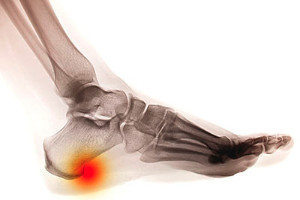 The symptoms of a heel spur are characterized by pain in the heel area of the foot. This is a result of a bony growth that develops between the arch of the foot and the heel. The type of discomfort that is felt may range from a dull ache to a sharp pain, in addition to swelling and tenderness. Heel spurs may be caused by disintegration of the soft tissues that are located in the heel. The heel pads may become thinner as a result of the aging process and may not provide adequate support that is needed for shock absorption. This condition may develop from frequently participating in running and jumping activities, and this may possibly cause the heel pads to gradually diminish. Additional factors, which may include obesity and wearing poorly fitting shoes may contribute to the onset of heel spurs. If you are experiencing heel pain, it is advised to seek the counsel of a podiatrist who can properly diagnosis and treat this condition.
The symptoms of a heel spur are characterized by pain in the heel area of the foot. This is a result of a bony growth that develops between the arch of the foot and the heel. The type of discomfort that is felt may range from a dull ache to a sharp pain, in addition to swelling and tenderness. Heel spurs may be caused by disintegration of the soft tissues that are located in the heel. The heel pads may become thinner as a result of the aging process and may not provide adequate support that is needed for shock absorption. This condition may develop from frequently participating in running and jumping activities, and this may possibly cause the heel pads to gradually diminish. Additional factors, which may include obesity and wearing poorly fitting shoes may contribute to the onset of heel spurs. If you are experiencing heel pain, it is advised to seek the counsel of a podiatrist who can properly diagnosis and treat this condition.
Heel spurs can be incredibly painful and sometimes may make you unable to participate in physical activities. To get medical care for your heel spurs, contact one of our podiatrists from PA Foot & Ankle Associates. Our doctors will do everything possible to treat your condition.
Heels Spurs
Heel spurs are formed by calcium deposits on the back of the foot where the heel is. This can also be caused by small fragments of bone breaking off one section of the foot, attaching onto the back of the foot. Heel spurs can also be bone growth on the back of the foot and may grow in the direction of the arch of the foot.
Older individuals usually suffer from heel spurs and pain sometimes intensifies with age. One of the main condition's spurs are related to is plantar fasciitis.
Pain
The pain associated with spurs is often because of weight placed on the feet. When someone is walking, their entire weight is concentrated on the feet. Bone spurs then have the tendency to affect other bones and tissues around the foot. As the pain continues, the feet will become tender and sensitive over time.
Treatments
There are many ways to treat heel spurs. If one is suffering from heel spurs in conjunction with pain, there are several methods for healing. Medication, surgery, and herbal care are some options.
If you have any questions feel free to contact one of our offices located in Allentown, Easton, Northampton, and Chew Street in Allentown, PA . We offer the latest in diagnostic and treatment technology to meet your needs.
How to Treat Heel Spurs
Heel spurs are calcium deposits that cause bone protrusions on the heel bone. Heel spurs are usually associated with plantar fasciitis, which occurs when the plantar fasciitis in the foot becomes inflamed. Typically, heel spurs don’t cause any symptoms. However, they can produce chronic or intermittent heel pain. Those who have had the condition often describe the irritation as a stabbing pain.
There are risk factors that may make you more likely to develop heel spurs. People who have abnormal walking gaits, run and jog on hard surfaces, are obese, or wear poorly fitting shoes are more likely to develop heel spurs.
Fortunately, there are precautions you can take to avoid developing heel spurs. One of the best ways to do this is by wearing well-fitting shoes with shock-absorbent soles. Another preventative technique is to choose running shoes if you plan on running, and walking shoes if you plan on walking. Shoes are made for different activities and it is important to research a shoe before you purchase a pair.
The pain associated with heel spurs often decreases the more you walk. However, a recurrence of pain after an extended period of rest or walking is likely to occur with this condition. Those with severe heel spur pain may opt to go the surgical route for treatment. However, more than 90% of those with the condition get better without surgical treatment. If you have a heel spur and want to know if surgery is right for you, you should go to your podiatrist and he or she will be able to conduct a pre-surgical test or exam to determine if you are an optimal candidate for surgery.
Foot Surgery as a Successful Treatment Option
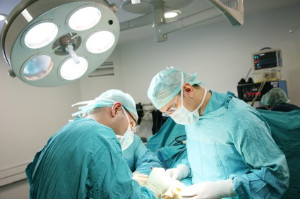 If chronic pain is present in the feet, surgery may be an option to consider. One type of surgery that is referred to as arthroscopic debridement may help patients in the beginning stages of arthritis. This procedure removes any inflamed tissue that has developed on the joints and surrounding areas. If you have a bunion and wearing shoes becomes painful, permanent removal of the bunion could be a successful treatment option. Many people experience heel pain. This may be indicative of plantar fasciitis, or heel spurs. These patients may find it beneficial to undergo heel surgery, which can be helpful in correcting the condition. Aftercare for most foot surgeries will typically consist of keeping the foot elevated, in addition to wearing a splint or bandage on the recovering foot. If you are considering any type of foot surgery, it is suggested to consult with a podiatrist who can properly guide you.
If chronic pain is present in the feet, surgery may be an option to consider. One type of surgery that is referred to as arthroscopic debridement may help patients in the beginning stages of arthritis. This procedure removes any inflamed tissue that has developed on the joints and surrounding areas. If you have a bunion and wearing shoes becomes painful, permanent removal of the bunion could be a successful treatment option. Many people experience heel pain. This may be indicative of plantar fasciitis, or heel spurs. These patients may find it beneficial to undergo heel surgery, which can be helpful in correcting the condition. Aftercare for most foot surgeries will typically consist of keeping the foot elevated, in addition to wearing a splint or bandage on the recovering foot. If you are considering any type of foot surgery, it is suggested to consult with a podiatrist who can properly guide you.
Foot surgery is sometimes necessary to treat a foot ailment. To learn more, contact one of our podiatrists of PA Foot & Ankle Associates. Our doctors will assist you with all of your foot and ankle needs.
When Is Surgery Necessary?
Foot and ankle surgery is generally reserved for cases in which less invasive, conservative procedures have failed to alleviate the problem. Some of the cases in which surgery may be necessary include:
- Removing foot deformities like bunions and bone spurs
- Severe arthritis that has caused bone issues
- Cosmetic reconstruction
What Types of Surgery Are There?
The type of surgery you receive will depend on the nature of the problem you have. Some of the possible surgeries include:
- Bunionectomy for painful bunions
- Surgical fusion for realignment of bones
- Neuropathy decompression surgery to treat nerve damage
Benefits of Surgery
Although surgery is usually a last resort, it can provide more complete pain relief compared to non-surgical methods and may allow you to finally resume full activity.
Surgical techniques have also become increasingly sophisticated. Techniques like endoscopic surgery allow for smaller incisions and faster recovery times.
If you have any questions please feel free to contact one of our offices located in Allentown, Easton, Northampton, and Chew Street in Allentown, PA . We offer the newest diagnostic and treatment technologies for all your foot and ankle needs.
Foot Surgery
In most cases, foot surgery is often chosen as the last available option for conditions that have otherwise been unsuccessfully treated. Surgery may be necessary for several reasons, including the removal of foot deformities (e.g. bone spurs or bunions), arthritis problems, reconstruction due to injury, and congenital malformations (e.g. club foot or flat feet). Regardless of one’s age, foot surgery may be the only successful option for treatment for certain conditions.
The type of surgery one undergoes depends on the type of foot condition the patient has. For the removal of a bunion growth, a bunionectomy is necessary. If the bones in the feet need to be realigned or fused together, a surgical fusion of the foot is needed. For pain or nerve issues, a patient may require surgery in which the tissues surrounding the painful nerve are removed. Initially, less invasive treatments are generally attempted; surgery is often the last measure taken if other treatments are unsuccessful.
While in many cases surgery is often deemed as the final resort, choosing surgery comes with certain benefits. The associated pain experienced in relation to the particular condition is often relieved with surgery, allowing patients to quickly resume daily activities. The greatest benefit, however, is that surgery generally eliminates the problem immediately.
Podiatry history has shown that foot treatments continue to evolve over time. In the field of foot surgery, endoscopic surgery is just one of the many advanced forms of surgery. As technology vastly improves so too will the various techniques in foot surgery, which already require smaller and smaller incisions with the use of better and more efficient tools. Thanks to such innovations, surgery is no longer as invasive as it was in the past, allowing for faster and easier recoveries.
Rheumatoid Arthritis: Symptoms & Causes
Rheumatoid arthritis is a chronic infla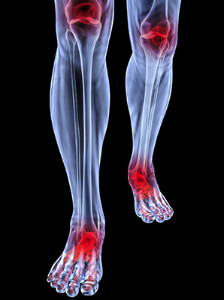 mmatory disorder that mainly affects the joints, but also can cause damage to other body systems. This form of arthritis occurs when the immune system mistakenly attacks the body’s own tissues. It affects the lining of the joints and causes painful swelling that can result in bone erosion and joint deformity in the ankles and feet. It can eventually cause the joint to stretch out, lose its shape and weaken all together. Some symptoms of rheumatoid arthritis include tender and swollen joints, joint stiffness, fever, fatigue and a loss of appetite. You are most at risk of getting the disease if you are a smoker, overweight and aged 55 or younger, as well as if you have had recent exposure to asbestos or silica. If you believe you may have developed rheumatoid arthritis or are experiencing any of the symptoms, it is advised you see a podiatrist.
mmatory disorder that mainly affects the joints, but also can cause damage to other body systems. This form of arthritis occurs when the immune system mistakenly attacks the body’s own tissues. It affects the lining of the joints and causes painful swelling that can result in bone erosion and joint deformity in the ankles and feet. It can eventually cause the joint to stretch out, lose its shape and weaken all together. Some symptoms of rheumatoid arthritis include tender and swollen joints, joint stiffness, fever, fatigue and a loss of appetite. You are most at risk of getting the disease if you are a smoker, overweight and aged 55 or younger, as well as if you have had recent exposure to asbestos or silica. If you believe you may have developed rheumatoid arthritis or are experiencing any of the symptoms, it is advised you see a podiatrist.
Because RA affects more than just your joints, including the joints in your feet and ankles, it is important to seek early diagnosis from your podiatrist if you feel like the pain in your feet might be caused by RA. For more information, contact one of our podiatrists of PA Foot & Ankle Associates. Our doctors will assist you with all of your podiatric concerns.
What Is Rheumatoid Arthritis?
Rheumatoid Arthritis (RA) is an autoimmune disorder in which the body’s own immune system attacks the membranes surrounding the joints. Inflammation of the lining and eventually the destruction of the joint’s cartilage and bone occur, causing severe pain and immobility.
Rheumatoid Arthritis of the Feet
Although RA usually attacks multiple bones and joints throughout the entire body, almost 90 percent of cases result in pain in the foot or ankle area.
Symptoms
- Swelling and pain in the feet
- Stiffness in the feet
- Pain on the ball or sole of feet
- Joint shift and deformation
Diagnosis
Quick diagnosis of RA in the feet is important so that the podiatrist can treat the area effectively. Your doctor will ask you about your medical history, occupation, and lifestyle to determine the origin of the condition. Rheumatoid Factor tests help to determine if someone is affected by the disease.
If you have any questions please feel free to contact one of our offices located in Allentown, Easton, Northampton, and Chew Street in Allentown, PA . We offer the newest diagnostic and treatment technologies for all your foot and ankle needs.
